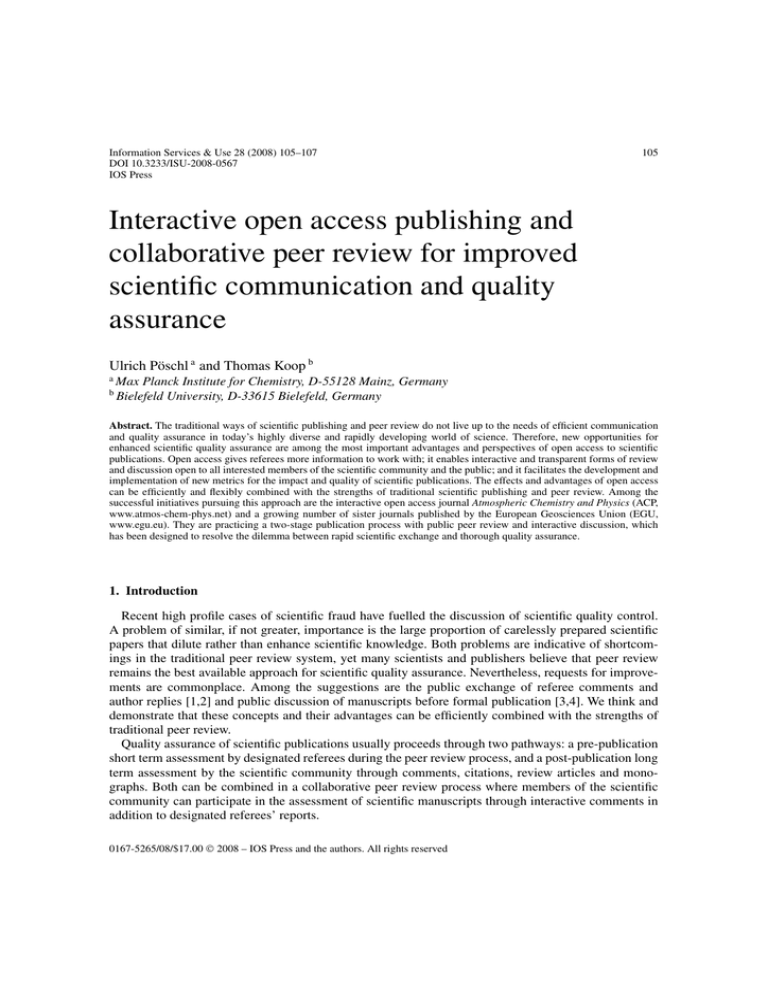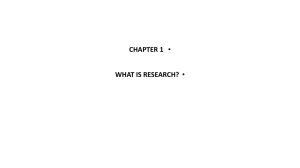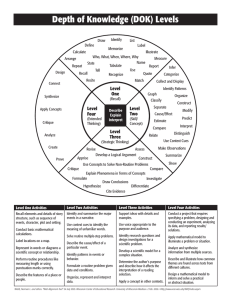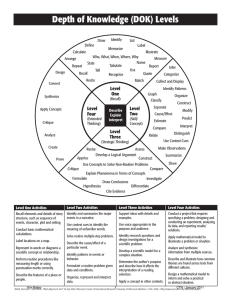
Information Services & Use 28 (2008) 105–107
DOI 10.3233/ISU-2008-0567
IOS Press
105
Interactive open access publishing and
collaborative peer review for improved
scientific communication and quality
assurance
Ulrich Pöschl a and Thomas Koop b
a
b
Max Planck Institute for Chemistry, D-55128 Mainz, Germany
Bielefeld University, D-33615 Bielefeld, Germany
Abstract. The traditional ways of scientific publishing and peer review do not live up to the needs of efficient communication
and quality assurance in today’s highly diverse and rapidly developing world of science. Therefore, new opportunities for
enhanced scientific quality assurance are among the most important advantages and perspectives of open access to scientific
publications. Open access gives referees more information to work with; it enables interactive and transparent forms of review
and discussion open to all interested members of the scientific community and the public; and it facilitates the development and
implementation of new metrics for the impact and quality of scientific publications. The effects and advantages of open access
can be efficiently and flexibly combined with the strengths of traditional scientific publishing and peer review. Among the
successful initiatives pursuing this approach are the interactive open access journal Atmospheric Chemistry and Physics (ACP,
www.atmos-chem-phys.net) and a growing number of sister journals published by the European Geosciences Union (EGU,
www.egu.eu). They are practicing a two-stage publication process with public peer review and interactive discussion, which
has been designed to resolve the dilemma between rapid scientific exchange and thorough quality assurance.
1. Introduction
Recent high profile cases of scientific fraud have fuelled the discussion of scientific quality control.
A problem of similar, if not greater, importance is the large proportion of carelessly prepared scientific
papers that dilute rather than enhance scientific knowledge. Both problems are indicative of shortcomings in the traditional peer review system, yet many scientists and publishers believe that peer review
remains the best available approach for scientific quality assurance. Nevertheless, requests for improvements are commonplace. Among the suggestions are the public exchange of referee comments and
author replies [1,2] and public discussion of manuscripts before formal publication [3,4]. We think and
demonstrate that these concepts and their advantages can be efficiently combined with the strengths of
traditional peer review.
Quality assurance of scientific publications usually proceeds through two pathways: a pre-publication
short term assessment by designated referees during the peer review process, and a post-publication long
term assessment by the scientific community through comments, citations, review articles and monographs. Both can be combined in a collaborative peer review process where members of the scientific
community can participate in the assessment of scientific manuscripts through interactive comments in
addition to designated referees’ reports.
0167-5265/08/$17.00 © 2008 – IOS Press and the authors. All rights reserved
106
U. Pöschl and T. Koop / Interactive open access publishing and collaborative peer review
2. Interactive open access journal concept
This approach is pursued by the open access journal Atmospheric Chemistry and Physics (ACP,
www.atmos-chem-phys.net) and a growing number of sister journals published by the scientific service provider Copernicus (www.copernicus.org) on behalf of the European Geosciences Union (EGU,
www.egu.eu). These journals have a two-stage publication process with public peer review and interactive discussion [5–8]. In the first stage, manuscripts that pass a rapid pre-screening (access review) are
immediately published as “discussion papers” on the journal’s website. They are then subject to interactive public discussion for a period of eight weeks, during which the comments of designated referees,
additional comments by other interested members of the scientific community, and the authors’ replies
are also published alongside the discussion paper. While referees can choose to sign their comments
or remain anonymous, comments by other scientists must be signed. In the second stage, manuscript
revision and peer review are completed in the same way as in traditional journals (with further rounds
of non-public revisions and referee review where required) and, if accepted, final papers are published
in the main journal. To provide a lasting record of review and to secure the authors’ publication precedence, every discussion paper and interactive comment remains permanently archived and individually
citable.
3. Atmospheric Chemistry and Physics
ACP was established in 2001 and now publishes about 500 papers per year. On average, one in four
papers receives a comment from the scientific community in addition to the comments from designated referees (in traditional journals this happens for about one in 100 papers). And there are typically
0.5 pages of comments and replies per page of original discussion paper. These cover the full spectrum
of opinions – from harsh criticism to open applause – and provide a wealth of additional information
and evaluation that is available to everyone.
ACP statistics confirm that collaborative peer review facilitates and enhances quality assurance. The
journal has a relatively low overall rejection rate of less than 20%, but only four years after its launch
ACP had already reached – and has since then maintained – the highest ISI journal impact factor in the
field of “Meteorology and Atmospheric Sciences” (48 journals) and one of the highest in “Environmental Sciences” (144 journals) and “Geosciences, Multidisciplinary” (131 journals) [9]. These numbers
support the anticipation that public peer review and interactive discussion deter authors from submitting
low quality manuscripts and, thus, relieve editors and referees from spending too much time on deficient
submissions.
This is particularly important, because refereeing capacities are the most limited resource in the publication process. While peer review depends crucially on the availability and performance of referees, it
has traditionally offered little reward for those providing careful and constructive reviews. In public review, however, referees’ arguments are publicly heard and, if comments are openly signed, referees can
also claim authorship for their contribution. Over six years at ACP, we have found that about two-thirds
of our referees prefer to remain anonymous. There are, however, interesting differences between subdisciplines: ∼50% of modellers sign their referee comments, while only ∼30% of the experimentalists
do so. It appears that modellers more often provide suggestions and ideas for which they like to claim
authorship as a reward [5–8].
U. Pöschl and T. Koop / Interactive open access publishing and collaborative peer review
107
4. Conclusions and outlook
We think that collaborative peer review with a two-stage publication process and interactive public discussion effectively resolves the dilemma between rapid scientific exchange and thorough quality
assurance. It has proven to foster scientific discussion, deter submission of sub-standard manuscripts,
save refereeing capacities, and enhance information density in final papers. Moreover, it can be flexibly integrated into existing journals as well as large scale publishing systems and repositories (such as
arXive.org) – simply by adding an interactive discussion forum.
In the geosciences, seven sister journals are already successfully practicing the interactive open access
journal concept of ACP (Biogeosciences, Climate of the Past, e-Earth, Geoscientific Model Development, Hydrology and Earth System Sciences, Ocean Science, The Cryosphere, www.egu.eu), and the
launch of further sister journals is foreseen. Moreover, the concept has been adopted by the recently
launched journal Economics, which is also aimed at top quality papers involves some of that discipline’s most prominent institutions and scientists (www.economics-ejournal.org). Modified concepts of
public peer review and interactive discussion are pursued by the open access publications PLoS One
(www.plosone.org) and Biology Direct (www.biology-direct.com) in the life sciences.
Overall, open access enables not only the maintenance but substantial improvement of scientific quality assurance, and it provides the basis for efficient usage and augmentation of scientific knowledge
in a global information commons [10]. Moreover, public review, discussion, and documentation of the
scientific discourse can serve as an example for rational and transparent procedures of settling complex questions, problems, and disputes, i.e. as a model for the further development of the structures,
mechanisms, and processes of communication and decision making in society and politics [11,12].
References
[1]
[2]
[3]
[4]
[5]
[6]
[7]
[8]
[9]
[10]
[11]
[12]
D.K. Lahiri, Discourse among referees and editors would help, Nature 439 (2006), 784; doi:10.1038/439784d.
D. Kennedy, Nick Cozzarelli, Science 312 (2006), 159; doi: 10.1126/science.1128103.
E.G. Van Meir, Opening the chamber of peer-review secrets, Nature 429 (2004), 803; doi: 10.1038/429803c.
L.B. de Carvalho, Pressure also leads to worthless publications, Nature 439 (2006), 784; doi:10.1038/439784a.
U. Pöschl, Interactive journal concept for improved scientific publishing and quality assurance, Learned Publishing 17
(2004), 105; www.ingentaconnect.com/content/alpsp/lp/2004/00000017/00000002/art00005.
T. Koop and U. Pöschl, An open, two-stage peer review journal, Nature Web Debate on Peer Review (2006);
doi:10.1038/nature04988, www.nature.com/nature/peerreview/debate/nature04988.html.
www.atmospheric-chemistry-and-physics.net.
www.atmospheric-chemistry-and-physics.net/general_information/public_relations_and_background_information.html.
www.atmospheric-chemistry-and-physics.net/news_acp_isi_impact_factor.pdf.
P.A. David and P.F. Uhlir, Creating the Information Commons for e-Science, Paris, 2005; www.codataweb.org/
UNESCOmtg/Book-of-Abstracts-InfoCommons2005-final.pdf.
U. Pöschl, Open access & collaborative peer review, DFG-iFQ Working Paper No. 1, 2006, p. 43; http://www.
forschungsinfo.de/Publikationen/Download/working_paper_1_2006.pdf.
E. Bodenschatz and U. Pöschl, Qualitätssicherung bei open access, in: Open Access Handbuch, B. Malina, ed., UNESCO
Kommission Deutschland, Bonn, 2007; www.unesco.de/fileadmin/medien/Dokumente/Kommunikation/Handbuch_
Open_Access.pdf.





